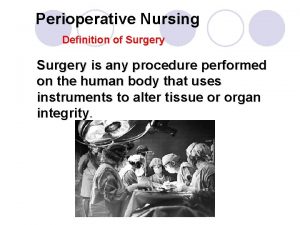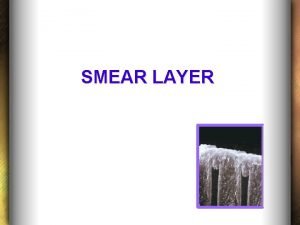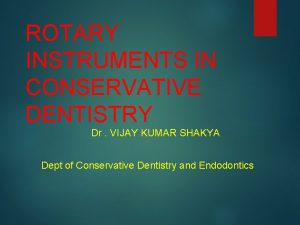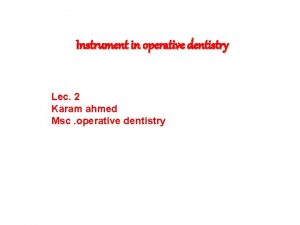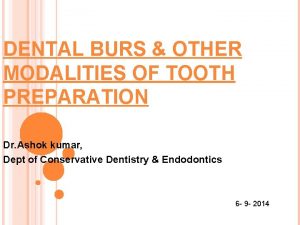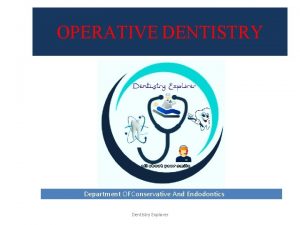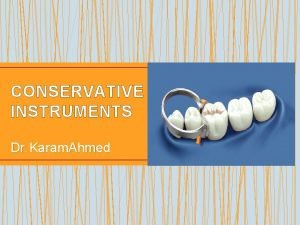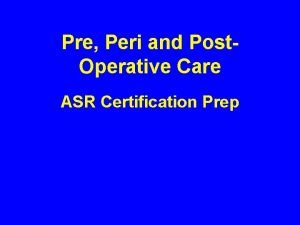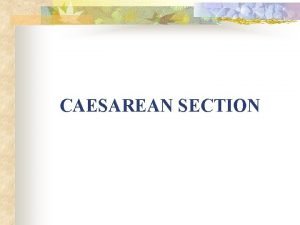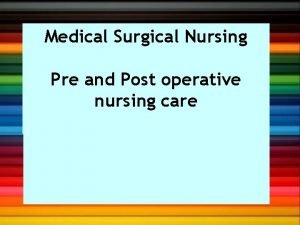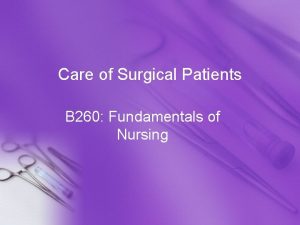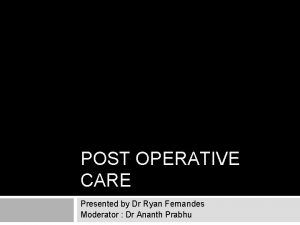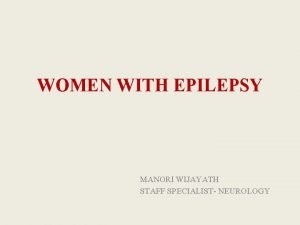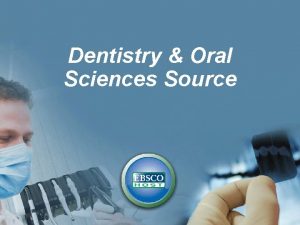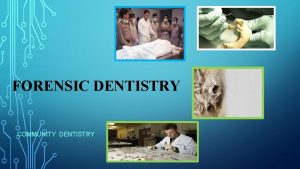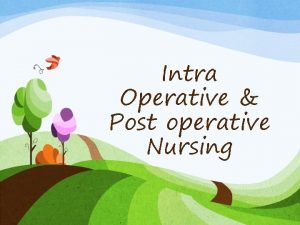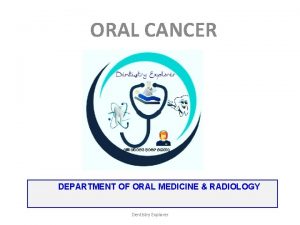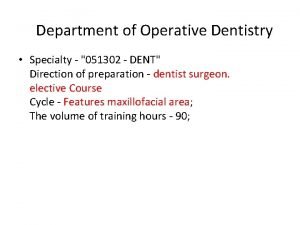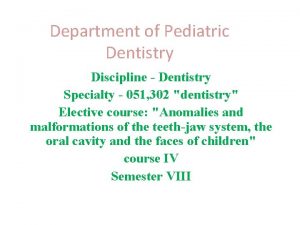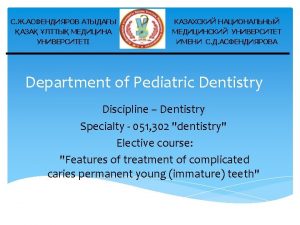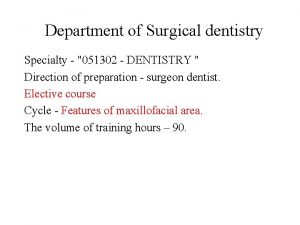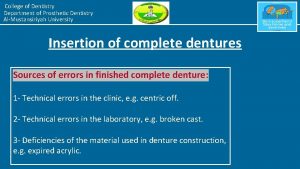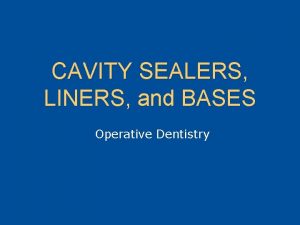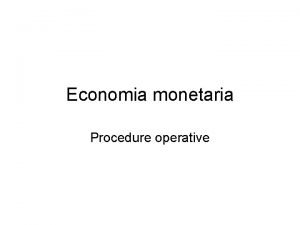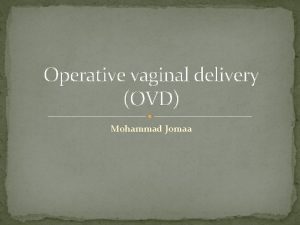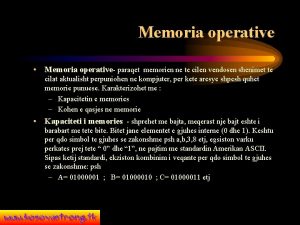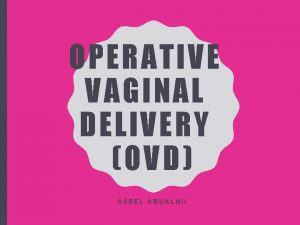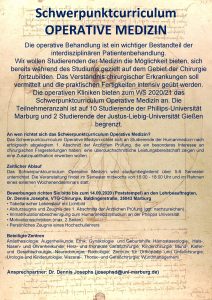Post operative management Department of Oral Dentistry and





















- Slides: 21

Post operative management Department of Oral. Dentistry and Maxillofacial Surgery Explorer

Contents • Introduction • Control of postoperative pain and discomfort – Diet – Oral hygiene – Edema – Control of infection – Trismus – Ecchymosis • Postoperative follow-up Dentistry Explorer

Introduction Once the surgical procedure has been completed, patients should be given proper instructions on how to care for themselves for the remainder of the day of surgery and for a few days afterward. Dentistry Explorer

Control of post-op pain and discomfort Dentistry Explorer

• The pain a patient may experience after a surgical procedure, such as tooth extraction, is highly variable and depends a great deal on the patient's preoperative frame of mind. • The surgeon who spends several minutes discussing these issues with the patient before surgery will be able to recommend the most appropriate medication. Dentistry Explorer

• All patients should be given instruction concerning analgesics before they are discharged • Even when the surgeon believes that no prescription analgesics are necessary, the patient should be told to take ibuprofen or acetaminophen postoperatively to prevent initial discomfort when the effect of local anesthetic disappears Dentistry Explorer

• The surgeon must understand the three characteristics of the pain that occurs after tooth extraction. • First, it is usually not severe and can be managed in most patients with mild analgesics. Dentistry Explorer

• Second, the peak pain experience occurs about 12 hours after the extraction and diminishes rapidly after that. • Finally, the pain from extraction rarely persists longer than 2 days after surgery. • With these factors kept in mind, patients can best be advised regarding the effective use of analgesics. Dentistry Explorer

• The first dose of analgesic medication should be taken before the effect of the local anesthetic subsides. • If this is done, the patient will not experience the intense, sharp pain after the loss of the local anesthesia. Dentistry Explorer

Diet You might eat soft foods as soon as the anesthetic wears off. Try not to chew directly on the extraction side. You might resume a regular diet as soon as you feel up to. You will heal faster if you are well nourished and hydrated. Dentistry Explorer

Oral hygiene • Patients should be advised that keeping the teeth and mouth reasonably clean results in a more rapid healing of their surgical wounds. • On the day of surgery patients can gently brush the teeth that are away from the area of surgery in the usual fashion. • They should avoid brushing the teeth immediately adjacent to the extraction site to prevent a new bleeding episode and to avoid pain. Dentistry Explorer

• The next day, patients should begin gentle rinses with warm salt water. • The water should be warm but not hot enough to burn the tissue. Dentistry Explorer

Edema Dentistry Explorer

• 1. Use an ice pack over the cheek directly over the surgical area. • 2. Keep it on 15 -20 Min then off 10 Min and repeat until you go to sleep. Then repeat the cycle the next day. • 3. Sleep with your head slightly elevated, above the heart. • 4. On the 3 rd day, change to moist heat instead of ice packs such as hot water bottles, heating pad. This will bring the swelling down quicker. Patient should also Dentistry Explorer

Control of infection • To control infection the surgeon must carefully • adhere to the principles of surgery. • No other special measures must be taken with • the average patient. Dentistry Explorer

Trismus • Extraction of teeth may result in trismus, or • limitation in opening the mouth. • This is the result of inflammation involving the • muscles of mastication. Dentistry Explorer

Prevention Use sharp, sterile and disposable needles Proper handling of needle Avoid contamination of needle and multiple injection Use minimum effective volume of LA Aspiration before infection. Management: Symptomatic Physiotherapy with jaw stretcher. Heat therapy, warm saline rinse, analgesics, muscle relaxant Dentistry Explorer

Ecchymosis • In some patients blood oozes submucosally (SM) and sub-cutaneously (SC), which appears as a bruise in the oral tissues on the face. • Blood in the subcutaneous tissues is known as • ecchymosis. • This is usually seen in older patients because of their decreased tissue tone and weaker intercellular attachment. Dentistry Explorer

• This anxiety is easily postoperative instructions. preventable by • Typically the onset of ecchymosis is 2 to 4 days after surgery and usually resolves with 7 to 10 days. Dentistry Explorer

Post-operative follow up visit • All patients should be given a return appointment so that the surgeon can check the patient's progress after the surgery. • In routine, uncomplicated procedures, a follow-up visit at 1 week is usually adequate. • If sutures are to be removed, that can be done at the 1 -week postoperative appointment. Dentistry Explorer

References • Contemporary Oral and Maxillofacial Surgery 6 th edition (Chapter 10). Dentistry Explorer
 Beaver tail burnisher
Beaver tail burnisher Pre and postoperative nursing management of cataract
Pre and postoperative nursing management of cataract Post operative nursing management
Post operative nursing management Post operative nursing management
Post operative nursing management Nursing diagnosis of ocd according to nanda
Nursing diagnosis of ocd according to nanda Smear layer composition
Smear layer composition Rotary instrument in dentistry
Rotary instrument in dentistry I wali
I wali Cutting instruments in operative dentistry
Cutting instruments in operative dentistry Parts of a dental bur
Parts of a dental bur Scope of operative dentistry
Scope of operative dentistry Instruments of conservative dentistry
Instruments of conservative dentistry Pre peri and post
Pre peri and post Complications of c section
Complications of c section Hernia nursing care plan
Hernia nursing care plan Post operative nursing care
Post operative nursing care Post operative nursing care
Post operative nursing care Post operative fever
Post operative fever Manori wijayath neurologist
Manori wijayath neurologist Dentistry & oral sciences source
Dentistry & oral sciences source Informative expressive and operative text types
Informative expressive and operative text types Informative, expressive and operative text types
Informative, expressive and operative text types


